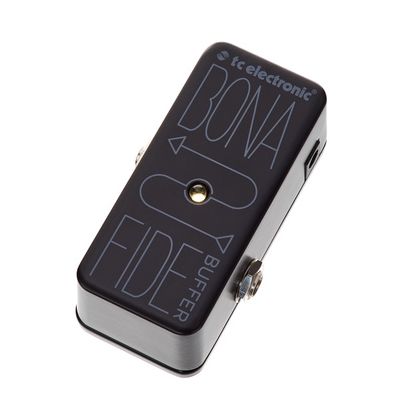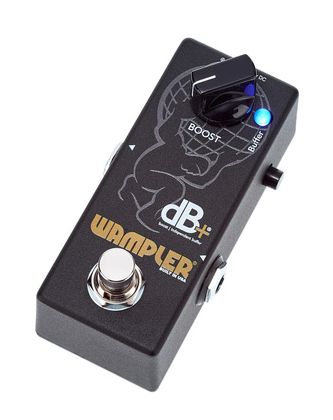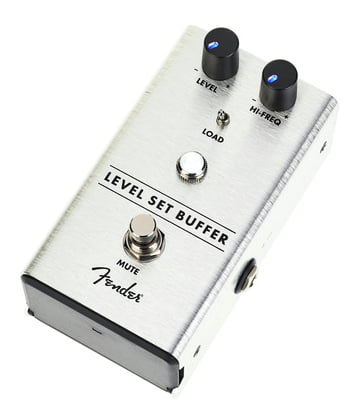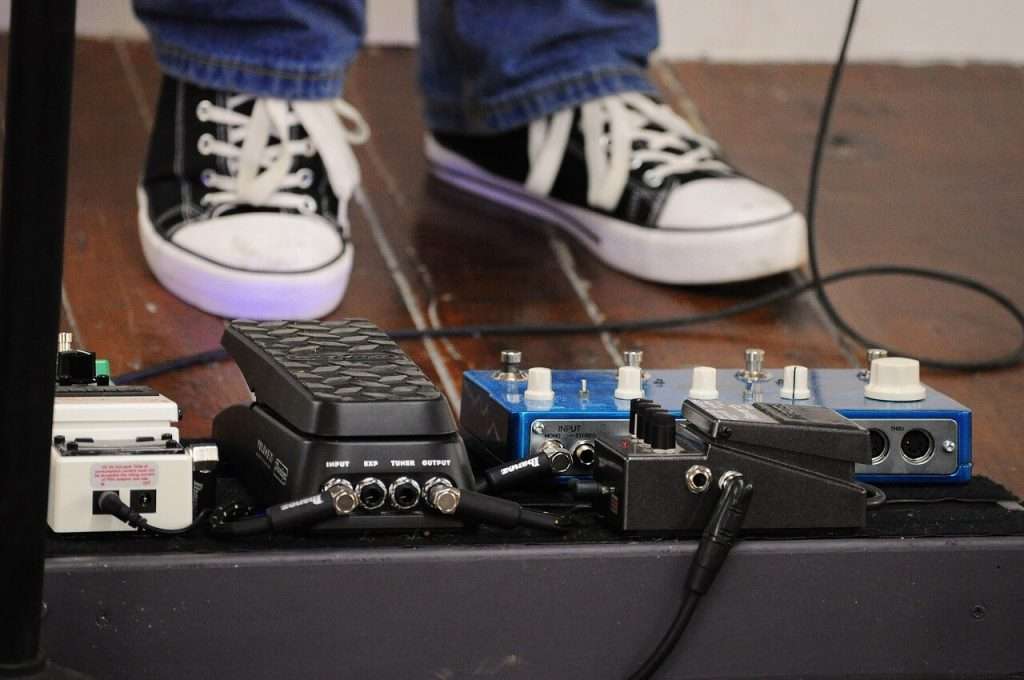
(This article contains affiliate links, that may earn us a small commission for every purchase without any additional cost for you)
When we have lots of pedals and very long runs of cable running around our playing spot we can often heard that something is off: the low and dull sound caused by long cables/too many effects is called “tone sucking” by the community of guitarists and you can solve this with a useful box called buffer pedal.
In this article we’ll see the best options for that utility stompox and the main perks of every model, in order to help you choose your best option for your own needs.
But first let’s see what does it happen behind the scenes.
WHAT IS A BUFFER AND WHY DO I NEED ONE?
When we play our electric guitar we send the signal from our guitar’s pickups through the cables right into the amp, eventually extending the “road” with some effect pedals in between.
The more cables and effects we have, though, the more is the capacitance (the resistance of the electronical parts that deteriorates the signal) and therefore the risk of cutting some sounds (usually high frequencies) is higher.
In order to solve this problem we have many options: using pedals with true bypass (you can check out how to improve your sound using true bypass and buffered bypass) will let you reduce that capacitance, but despite they prevent the signal to deteriorate, if you have a very long route between your guitar and your amp you can still have a weakened sound at the end.
For this reason we can use a buffer: this is an amp-like device that returns the same volume outputs but restore the impedance (that can be defined as the strenght of the signal) sending out a restored signal, fixing the deterioration given by cables and other electronical components.
BUFFER PEDALS: LIST AND FEATURES
1. TC ELECTRONIC BONAFIDE
CHECK OUT THE LOWEST PRICE ON AMAZON WEBSITE
This compact and durable stompbox is one of the best analog buffer, and it offers the essential options: if you are searching for something without lots of additional stuff and gimmick but only want the main feature, then this is indeed a great option!
FEATURES:
- Strong and durable metallic enclosure;
- Compact and small;
- Input with 1 MΩ impedance and output with 100 Ω;
- Total Harmonic Distortion of 0.001%;
- Power failure mode: if power gets cut out, then this switches to a True Bypass even without electricity, in order to not block the signal and simply letting this through the circuits without causing a failure of the whole signal chain;
- Price range: usually between 60 and 70$;
- Dimensions: 7.6 x 10.2 x 7.6 cm
2. JHS LITTLE BLACK BUFFER
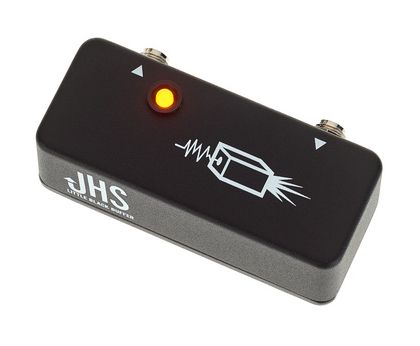
CHECK OUT THE PRICE ON AMAZON SITE CLICKING HERE NOW
This is another essential one, with the only function of a buffer and therefore available at a relatively cheap price.
This active buffer will restore the sound if placed in between or at the end of the signal chain and will make a stronger sound and an improved quality of the signal if placed at the beginning.
Another characteristic is the lack of controls: you only have one Input, one Output and a Led light that lets you know whether the circuit is on and is working, so you don’t have to turn knobs and try lots of settings in order to make this work properly.
FEATURES:
- Very compact;
- Can be placed underneath your pedalboard;
- it has a hard enclosure and is rugged, in order to make it more durable and probably to make it last for a long time without having to replace that box;
- The colour makes it “stealth” and can easily be hidden in the background;
- Price range: 80$-100$
- Dimensions: 15.2 x 7.6 x7.6 cm;
- If the power cuts out it automatically switch to True Bypass, without blocking your sound and the incoming signal
Hear a demo in the video below:
3. TRUETONE PURE TONE BUFFER
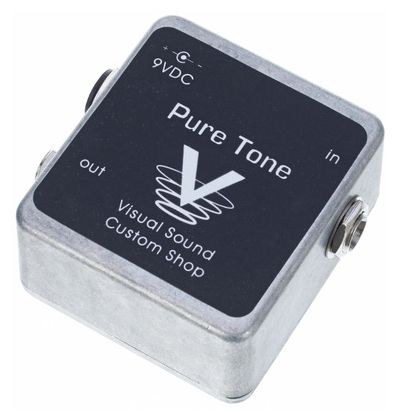
CHECK OUT THE PRICE ON AMAZON CLICKING HERE
Another essential and easy-to-use pedal (no knobs and no controls, it’s just plug and go), this has 60x63x30 cm dimensions and with its almost-square shape it can be put almost anywhere in your pedalboard, even with very little space.
Features:
- High-end preservation and signal buffer;
- very compact shape and dimensions;
- No controls and very easy to use;
- You just have to plug into the signal chain (unfortunately, this doesn’t have a LED that shows whether it’s on or not, but you can easily hear if it’s working)
- Dimensions: 63 x 60 x 30 mm
4. WAMPLER DB+ V2
CHECK OUT THE PRICE CLICKING HERE
This pedal works both as a buffer and as a boost for your sound: beyond restoring the strenght of the signal it also let you give an extra to the volume of your playing when On.
This stompox features a “Boost” control that let you decide how much boost you want, and a led light for when the buffer is on: when used for boosting the guitar’s sound it also adds a little of extra colour to your sound, giving your riffs and solos even more life.
When used for buffering the signal alone, though, it remains very crisp and doesn’t alter a lot the sound.
FEATURES:
- Cristalline sound when used for buffering and a little added colour when used for boosting;
- One single control for the boost-part of this pedal, while the buffer is always on when plugged in (as showed by the led light on the stompbox);
- Dimensions: 17.8 x 10.2 x 17.8 cm
- Ideal for highlighting riffs and solos
5. FENDER LEVEL SET BUFFER
CHECK OUT THE PRICE CLICKING HERE
This Fender’s stompbox is a very flexible option for your rigs, as it is optimised both for single-coil output than for humbucker one, so you can switch your guitars effortessly as you gig or play at home without having to change the settings.
The Fender Level Set features a “Level” knob, for adjusting the buffering level, as well as a Hi-Freq knob (for letting you set how many treble you want) and a “Load” switch, that let you adjust the strenght of your signal.
Another great feature is the “Mute” footswitch, that lets you mute your guitar and is particularly useful for tuning (and basically for this alone), so you don’t have to worry unplugging the cable or having to lower the volume during your guitar playing.
Last but not least, the enclosure is very high-quality and will indeed have a long life without any major damages (well, in most of the cases at least).
FEATURES:
- Highly-customizable buffer (Level and Hi-Freq knobs and Load toggle switch for adjusting the strenght of your signal);
- “Mute” footswitch available;
- It is optimised for both single-coil and humbucker and doesn’t require to change settings when you switch between single-coil and humbucker guitars;
- Aluminum enclosure, very durable and solid;
- Dimensions: 13.8 x 12.3 x 8.3 cm
You can check out more at Fender Website and also hear a demo in the video below:
WHERE SHOULD I PUT THE BUFFER IN MY PEDAL CHAIN?
You can place it in many positions in your effects chain, but the main positions are:
- As the very first pedal, for an improved starting quality (but if you have a wah wah or a fuzz it can flatten the sound for the wah and make a darker and hard to manage sound for the fuzz, because the first works as a filter for several frequencies and can work worse receiving the signal straight out of a buffer, and the last can as well work bad receiving the buffed input);
- At the end of the effects chain, right before the amp (or at least after the last overdrive/distortion/fuzz pedal), for a restoration of the signal’s strenght that will come right into the amp;
- You can also place it in the middle, especially if you have lots of stompboxes and/or lots of true bypass effects, but you may have to try several combinations and positions in order to take out the best sound for playing (as said before, fuzz reacts bad with a buffer right before them in the signal chain, and the same can be said for a good part of distorsions and also filters like the wah-wah, but it can really depends on the single model and the design of every specific model)
In short, you’ll usually have to experiment a bit in order to find the best placement, but a bit of trial is surely worth it giving the great sound improvement that you can get with a buffed sound!
CONCLUSION: THE BEST BUFFER PEDALS
In conclusion, the quest for the perfect guitar tone often leads us to explore various pedals and effects, but as we accumulate gear, we also encounter the dreaded “tone sucking” effect caused by long cables and multiple effects in our signal chain. The solution to this problem lies in the unassuming yet essential tool known as the buffer pedal.
In this article, we’ve explored some of the best buffer pedal models available, each with its unique features and advantages. Whether you prefer the simplicity of the TC Electronic Bonafide, the no-frills functionality of the JHS Little Black Buffer, the compact and easy-to-use design of the Truetone Pure Tone Buffer, the dual-purpose capability of the Wampler DB+ V2, or the flexibility of the Fender Level Set Buffer, there’s a buffer pedal that suits your needs.
These devices serve a crucial role in maintaining the integrity of your guitar’s signal by mitigating the capacitance and impedance issues that can arise from lengthy cable runs and multiple effects in your signal chain. When strategically placed in your pedalboard, buffer pedals ensure that your guitar’s tone remains clear and vibrant, allowing you to fully enjoy the sonic possibilities of your gear.
Remember that the ideal placement for your buffer pedal may require some experimentation, as the specific configuration of your pedalboard and the nature of your effects can influence the best position. However, the effort invested in finding the optimal placement is well worth it, given the significant sound improvement you can achieve with a properly buffered signal.
